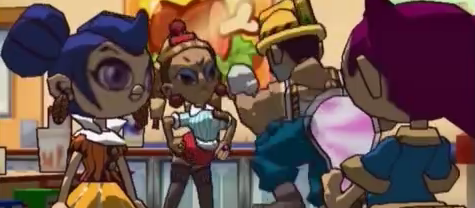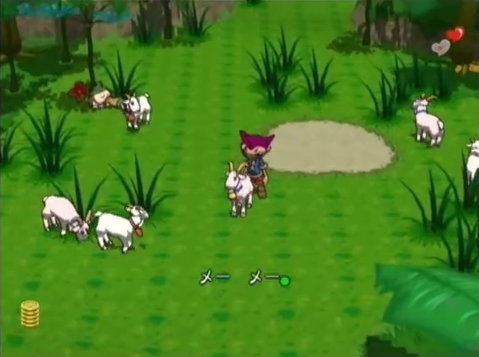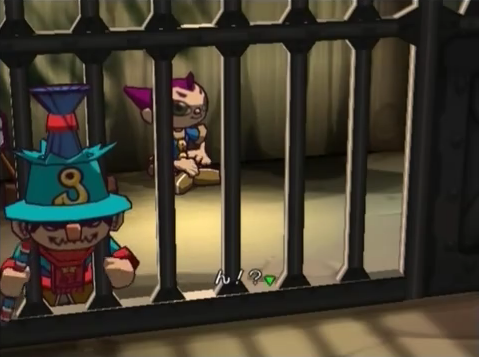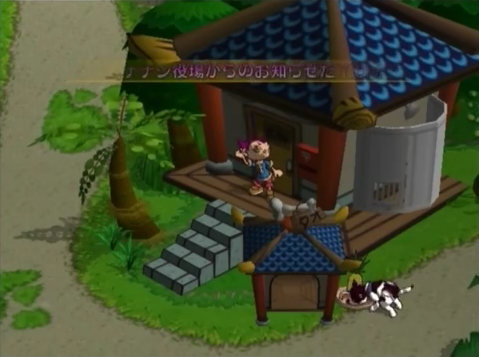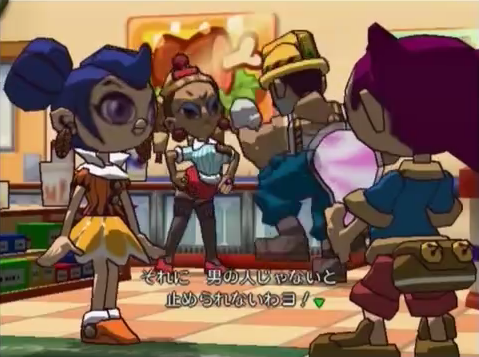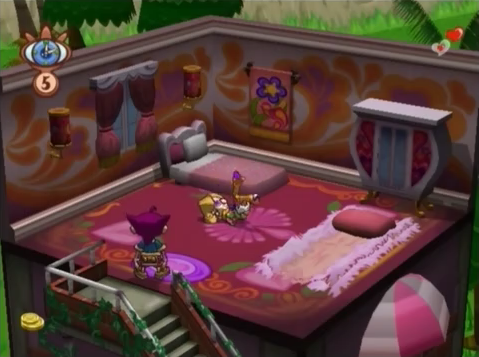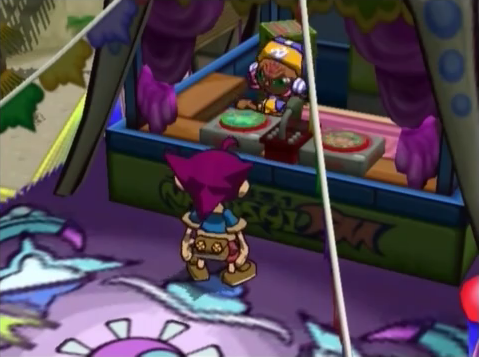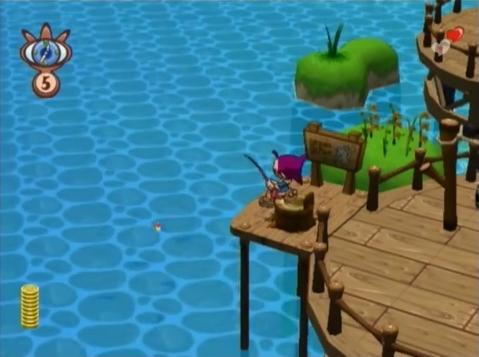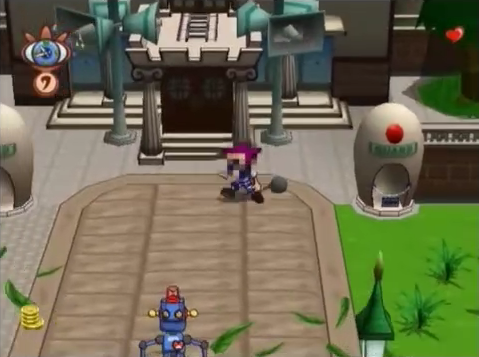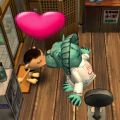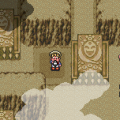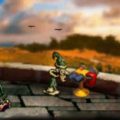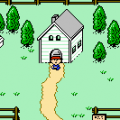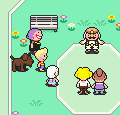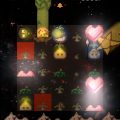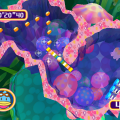GiFTPiA was developed by skip and published by Nintendo on the GameCube in 2003. For the record: You may already know about skip, the guys behind Chibi-Robo! and bit Generations. But what you may not know is that this developer – along with Vanpool (Tingle’s Rosy Rupeeland) and Punchline (Chu♥Lip, Rule of Rose) – is an offshoot of Love-De-Lic, a studio funded by former Square employees back in 1995. They achieved niche fame in Japan with only three games, hailed for their striking originality – Moon: Remix RPG Adventure and UFO: A Day in the Life for the PlayStation, and L.O.L.: Lack of Love for the Dreamcast – before closing down in 2000. It’s only natural GiFTPiA would continue this tradition of experimental gaming, especially since it was designed by Love-De-Lic founder Kenichi Nishi, who had already worked on moon and L.O.L. as a director. So what kind of gameplay will GiFTPiA offer to us curious gamers?
The whole game takes place on Nanashi Island, an isle in the middle of nowhere (hence the name, “Nanashi”, meaning “Nameless”). In this region, out-of-season typhoons are not rare events. But why did one have to occur on the day of the Coming of Age Ritual? This is the day in which Pokkle, our protagonist, is supposed to become an adult. But the carefree lad is in bed, in the middle of a dream, and is missing the whole thing! The people attending the Ceremony wait and wait, but Pokkle doesn’t show up. And in the end, everyone leaves in a rage. Pokkle eventually jumps out of his bed, but the mayor, Mr. Mayer, bursts into his bedroom anger and screams: “THIS IS TREASON!”. And thus Pokkle is sent to jail. Will Pokkle ever be able to become an adult? That’s how GiFTPiA begins.
GiFTPiA calls itself an “alternative RPG“. It’s true it’s a bit difficult to define what genre GiFTPiA belongs to, if any. Let’s say it’s a very special adventure game, since there is basically no action element in it. Actually, the game look likes an unexpectable blending of Animal Crossing and Zelda, minus the battles of the latter, with emphasis both on social interactions with NPCs and exploration of the environment. This also means that it’s very heavy on text. The game was only released in Japan, and considering it was probably the most daring Nintendo production since Mother 2 back in 1994, it was pretty obvious it would never make it to the West. Indeed, Nintendo of America ultimately decided it was “too weird” for us Westerners. And seeing the game contained a ton of text and could not be played without advanced knowledge of the Japanese language, this meant it was out of our reach. That is, until Team Kirameki, a young Italian pair dedicated to translating Japan-only games, put a lot of effort in the translation of this lost gem. And as of March 2011, the script was released. Of course, playing with a script isn’t really a flawless experience: not only is playing and reading at the same time unpleasant, but the translation in itself isn’t 100% complete. Of course, everything necessary to complete the game is there, along a great deal of NPC dialogues; however, speeches delivered by said NPC when presented with an item are left untranslated, which is nothing fatal but is certainly detrimental to the game’s overall identity. Of course, we can’t blame Team Kirameki, since translating that much would have been nearly impossible.
When you start the game, you assume the role of Pokkle, who is defaced with pixels and shackled to a millsto- wait, what? What, you’re surprised? That’s right, that’s how you start the game: in the crowbar hotel. Your first mission? Community work – that is, cleaning the island’s town square under the watchful eye of over-zealous cop robot Mappo with an old, skipping vinyl record as background music. But that’s not all. The Nanashi Island Constitution is clear: if you want to attend the Coming of Age Ceremony again, you’ll have to pay 5,000,000 Manes, the currency of the Island. You’ve surely seen better days.
Hopefully for you, you’ll gather the 10,000 Manes to pay the fine and be let out of your jail cell. Even though your mobility is still constrained with ball and chain, your short time as a convict will be your first contact with the gameplay mechanics that serves as a basis for GiFTPiA, as you still get to walk around for a bit. Well, don’t walk around too much, though, as that heart meter isn’t here for show: it’s actually an hunger meter. If you wander for too long without eating, you’ll die, pure and simple. And the lower the meter, the slower your movement. Don’t worry, though: You’ll find fruits here and there on the island that will replenish your meter. Actually, what you should really be careful about is the hour of the day. Indeed, you’re still a kid after all, so if you don’t go back home before it’s too late – that is, before the clock-meter reaches 0 – you’ll simply fall asleep on the ground, and the Sleep Fairy will come to steal all your goods, money and items. The world is a harsh place. For those who already have played Chibi-Robo!, this mechanic should remind you of the home base you had to go back to in order to recharge yourself when you started to get low on batteries. The concept remains similar: it’s a way to restrain your capacity of progression through the open world without imposing too much preset and immutable physical barriers. It also forces you to adapt your time planning to an additional factor that will, of course, become less and less constraining as you progress in the game.
And yes, this means managing your time properly. Being informed of the time of the day isn’t only useful as a simple indication of how many time is left before you have to go to sleep, but as a way to organize in relation to other characters: NPC have schedules too, and you’ll have to coincide with them when you want to meet them. More than adding to the gameplay, it really gives the little town of Nanashi Island a life of its own. The simple fact that the mayor leaves his workplace everyday to go and doze off on a bench of the square may seem of little significance, but it contributes to an atmosphere of constant activity that makes you feel like the town really is living on its own while you’re walking around, minding your own business.
Well, about that. What kind of business could you have on Nanashi Island? Even once you get out of jail, the Law demands that you pay for a new Coming of Age Ceremony. So, in order to gather Manes, you’ll have to apply for part-time jobs and carry out various odd jobs, like frog catching. You can sell fishes and fruits, too. And… that’s about it. After awhile, more facilities begin to open up and continue to gather more stuff. That is, until you meet some guy named Ziggy. He’s an old hippie folk, living on the margin of society in a tree decorated with icons of Nanashi Island’s guardian god. He decided never to attend the Coming of Age Ceremony, and he doesn’t want to hear anything about money or laws. So when he learns Pokkle is condemned to pay for the right to become an adult, it kind of gets on his nerves. He doesn’t hide his resentment towards the mayor when he beats the crap out of Mappo. (“The State’s power? My foot!”) That’s when he decides to tell Pokkle something of utter importance: he can very well become an adult without having to pay millions of Manes, or even attend a ceremony. After eating a mushroom stew at Ziggy’s place, Pokkle starts to experience hallucinations, in which he meets the… Shroom Fairy, who reveals him the true way to becoming an adult: by fulfilling wishes. That’s when the true adventure of GiFTPiA begins.
But what is “wish fulfilling” about? Well, there’s a small temple next to your home. After a few offerings, you’ll get a Gem in exchange. What you’ll want to do next is find a townsfolk with a wish to fulfill and show him the Gem, which will inform you of the mission to carry out. The Gem will fill itself with the character’s wish. Now, it’s up to you to find the way to complete what you were requested… Once it’s done, the Gem will start to glow, and become fit for offering to the statue at the back of the temple. That’s how the scenario progresses, since completing a Gem will unlock another one. Regarding these missions, they are pretty simple in nature. In most cases, bringing a couple of items or fetching some people will be the key to trigger cutscenes and eventually fulfilling the wish. Once all the wishes of a chapter are fulfilled, the Shroom Fairy will tell you that you have “grown up” and, not only will the scenario progress even further, but you’ll be allowed to stay up later at night as well.
In the end, GiFTPiA‘s gameplay is actually quite minimalistic: explore, survive, solve simple quests and complete a bunch of other tasks here and there. Indeed, most – if not all – of the game’s interest lies upon character interactions. GiFTPiA is a social game whose force is to be found in its background. So, what’s so great about it? It’s quite a difficult question to answer, as reception of the game’s quirky cast may vary a great deal from player to player. GiFTPiA‘s cast really is something, and even if Chibi-Robo! fans will appreciate the return of cell-shaded graphics and “puirt a beul” voices, it really stands out as unique. Pokkle and his girlfriend Kyappi are adorable, and some NPCs like Peevee the kitschy transvestite are downright unforgettable. Whatever you may expect, prepare for something you’ve never seen before.
The imaginative character designs are matched in quality by the soundtrack. If you happened to bump into the title theme, you probably already have a little idea of what it may sound like. Once again, only GiFTPiA could have featured choirs chanting in an imaginary language right on the title screen. The music, composed by Hirofumi Taniguchi – who worked on Chibi-Robo!, as well as on the likes of beatmania III and Suikoden V – maintains that otherwordly twist to it up untill the end. Every character has its own theme, and they all serve them right; this only adds to their uniqueness. But well, guess what: Taniguchi’s score isn’t actually the main part of the soundtrack. Nope. GiFTPiA‘s real auditive tour-de-force is Nanashi FM. What is it? Well, it’s Nanashi Island’s radio station, pure and simple. Indeed, during your exploration of the island, there is no preset BGM. Every morning, radio host DEEJ will announce the day’s broadcast, and it will serve as your BGM. Every last track on this soundtrack was contributed by independant bands or individuals, 19 in total. These tracks come from completely different genres: techno, jazz, hip-hop, country, post-rock, dream pop, and more. This “custom” OST really is something BIG. And, believe it or not, but eating bananas next to a goat that goes “meh meh” while listening to metal has got a magic vibe to it. One of the best is Yuzo Kako’s pop_errong song: it’s amazing that someone as obscure as Yuzo Kako, who produces experimental/minimalist electronic music for underground labels, would actually take part in a Nintendo game. It’s clear that GiFTPiA‘s soundtrack is of a rare quality; it’s the icing on the cake of the game’s aesthetics. It’s very daring, incredibly well produced and varied enough never to get repetitive.
As stated before, the game’s soundtrack is reminiscent of its overall design. Playing GiFTPiA is an experience that does its best in immersing the player into a unique atmosphere. Actually, the game puts so much effort into it that it feels like the gameplay in itself was left out a little bit. Of course, it’s nothing terrible, but it certainly feels like some parts are incomplete or improperly exploited. This leads to a noticeable drop in rhythm towards the last part of the game – some quests really are shallow, and the ending is pretty dull to be honest. The focus on the game’s social aspect is the reason behind this lack of gameplay depth, but improving the fetch quests would have added yet another plus in the player’s immersion into the life of Nanashi Island. Despite these cons, GiFTPiA is a unique experience. There is probably a whole lot of games that aren’t as flawed as GiFTPiA, but they’ll never get anywhere near its uniqueness, and you’ll cry for more of it when the credits are finished rolling. It’s now up to you to decide wheter or not you’re okay with its chattiness, but you’ll definitely miss something if you don’t at least try it out to see for yourself.
In case you’re left wanting more, GiFTPiA‘s got a spiritual sequel called Captain★Rainbow, which was released for the Wii in 2008. It’s made by the exact same team behind GiFTPiA and features very similar gameplay, which means the guys at skip can learn from their last experience and try to correct what was wrong with it, plus it features a ton of Nintendo cameos. Bad news: it also had the same release model as GiFTPiA. It was announced that the game would be released outside of Japan, but poor sales prompted Nintendo to cancel localization. The sorrow would have been unbearable… if Team Kirameki hadn’t come to our rescue again! Indeed, not only are our two saviors currently working on a script translation of this game, but a patch is also planned this time. As of November 2011, it is about 20% complete, so let’s hope their progress will go smoothly so we can play this game as soon as we can.
Screenshots were produced using this Nico Nico playthrough as a source.
